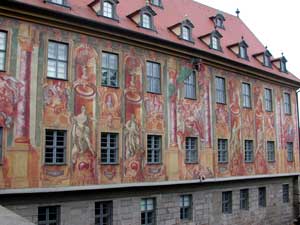This is our second visit to Bamberg. We put this city on our agenda in October, 1999 when Nina and I were in Europe on vacation following a business meeting in Munich, Germany.  We spent a night and a day in Rothenberg on der Taube and had a delightful time (We’ll be in Rothenberg tomorrow) and then drove to Bamberg to spend the night and the next day. We didn’t find Bamberg to be so very interesting and about noon on our 1999 visit, left the city to go out in the countryside and then on to our next stop in Nuremberg. The write-up on Bamberg in our cruise itinerary sounded like a very different city than we had visited in 1999 so we were very curious to see what the guided tour of Bamberg would reveal.
We spent a night and a day in Rothenberg on der Taube and had a delightful time (We’ll be in Rothenberg tomorrow) and then drove to Bamberg to spend the night and the next day. We didn’t find Bamberg to be so very interesting and about noon on our 1999 visit, left the city to go out in the countryside and then on to our next stop in Nuremberg. The write-up on Bamberg in our cruise itinerary sounded like a very different city than we had visited in 1999 so we were very curious to see what the guided tour of Bamberg would reveal.
We docked in Bamberg right about 11 a.m. this morning after cruising the rest of the Rhine-Main-Danube Canal. It was a pleasant morning. I spent it in the lounge classifying digital pictures that will eventually end up on the web page. After lunch we disembarked for a short bus ride to the center of the city where we met our city guides. We stayed with our guide until the start of the climb up the hill to the cathedral. We’ve already been there and didn’t want to make the climb again. Besides, the stores were open and we wanted to do a little shopping. It is still the same city. Our tour guides did not reveal anything new or show us anyplace that we hadn’t already visited. It was a bit more interesting today only because we haven’t yet been to Rothenberg….!!
Bamberg is a very old city on a trade route made possible by the Main River (pronounced “mine”). Similar tension existed here between the Bishop of the Catholic Church and the Mayor and citizens of the city. This tension has been a very common theme in Passau, Regensberg, and now Bamberg. At least in Bamberg the Bishop didn’t make war on his congregation as he did in Passau. That tension still exists to some extent in Regensberg where the guides employed by the city’s tourist bureau aren’t allowed to take tourists into the cathedral. The general architecture in Bamberg is buildings made first of big criss-crossing timbers, then the spaces between the timbers filled up with a plaster. Then, because wood timber houses were considered to be “cheap” houses, most were then plastered over, and in some cases, painted to look like stone buildings.
Bamberg is also a U.S. Army city. About 4,000 soldiers are stationed in Bamberg and about a thousand of them are currently in Iraq. When we lived in Germany in the mid-1970’s, there were more than a quarter of a million U.S. military personnel and their families in Germany. In 1992 a large drawdown started and there are probably less than 30,000 U.S. military in the country now. Bamberg serves as a logistics and supply center and was once very strategic in its position relative to East Germany. Today’s world situation is significantly different and Bamberg’s usefulness has certainly diminished and perhaps even disappeared. However, the Army presence makes a significant contribution to the local economy and that has become quite important to the Germans. In the 1980’s they couldn’t wait for us to leave. Then when the drawdown started and we actually began leaving, the economic impact became very visible and painful. Now folks aren’t as anxious for the troops to leave….
After we ditched the tour, we spent some time window shopping and actually buying a few things. We visited a store selling antique Christmas Creches (manger scenes) and we did spend a little money there. The big shopping (if any of it can be considered to be “big”) will be tomorrow in Rothenberg.